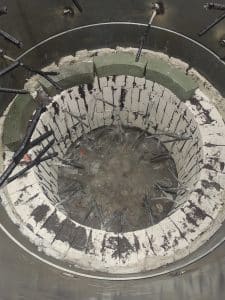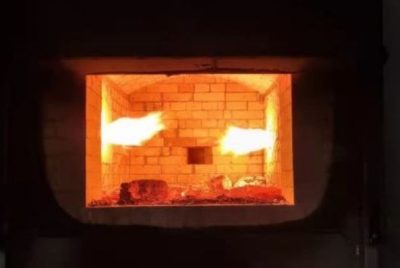Refractory bricks are an indispensable protective material in industrial kilns and high-temperature equipment. The production process not only requires a deep understanding of material science, but also precise control of process technology. Behind the creation of high-quality refractory bricks is a series of carefully designed steps, each embodying the pursuit of perfect heat-resistant properties. The following will introduce the key processes in the production of refractory bricks:

refractory bricks
1. Carefully select raw materials
Strict screening: The first step in producing refractory bricks is to select high-quality raw materials. This includes a variety of refractory powders, binders and additives. Each raw material must undergo rigorous quality testing to ensure they can withstand extremely high temperatures while maintaining chemical stability and mechanical strength.
Scientific proportioning: Accurate raw material proportioning is a key factor in determining the quality of refractory bricks. Through scientific calculations and experiments, the best proportioning scheme is found to ensure that the refractory bricks not only have excellent fire resistance, but also meet the thermal stability and slag resistance requirements under specific conditions of use.
Innovative research and development: Continuous exploration and utilization of new raw materials, such as the use of nanotechnology and advanced composite materials, can significantly improve the performance of refractory bricks, broaden their application scope, and meet more stringent industrial needs.
2. Precisely prepare blanks
Uniform mixing: Ensuring that all raw materials are highly uniform during the mixing process is the key to preparing high-quality blanks. The use of advanced mixing equipment and technology, such as high-speed stirring or ball milling, can fully integrate various raw materials and avoid component segregation.
Aging treatment: Through aging treatment, the mixed blank is allowed to stand for a period of time under certain conditions to eliminate air bubbles in the material, improve its density and plasticity, thereby improving the molding effect and the durability of the final product.
Strict control of particle size: Control the particle size distribution of raw materials to ensure that each raw material can be perfectly combined. This not only affects the formability of the blank, but is also directly related to the density and uniformity of the refractory bricks, and is an important link in improving product quality.
3. Precise molding
Diversified molding methods: According to the needs of different types of refractory bricks, select appropriate molding methods, such as dry pressing molding, pouring vibration molding, etc., to obtain the best molding effect. Different molding methods can adapt to the production of refractory bricks of different shapes and sizes, ensuring product accuracy and consistency.
Control the molding pressure: Precisely control the pressure during the molding process, which not only ensures the integrity of the shape of the refractory bricks, but also avoids cracks and damage caused by excessive pressure. This process requires experienced operators to monitor and ensure that each refractory brick meets the expected quality standards.
Keep the environment stable: During the molding process, it is very important to maintain stable environmental conditions. Environmental factors such as temperature and humidity will affect the fluidity and molding effect of the blank, so molding must be carried out in a controlled environment to ensure the stability and reliability of the product.
4. Burn carefully
Precise temperature control: The firing of refractory bricks is a complex and delicate process. The heating and cooling rates, as well as the maximum firing temperature, must be precisely controlled, as these are key factors that determine the microstructure and macroscopic properties of refractory bricks.
Atmosphere adjustment: At different firing stages, by adjusting the atmosphere in the kiln, the physical and chemical changes of the refractory bricks can be effectively controlled, such as promoting or inhibiting certain chemical reactions, to ensure that the performance of the product reaches its optimal state.
Post-processing optimization: The cooling rate after firing is equally important as the subsequent processing. A reasonable cooling rate can reduce the internal stress of the product and avoid the occurrence of cracks; and post-processing processes, such as the detection of physical and chemical indicators and appearance modification, are the last guarantee to ensure product quality.
5. Strict inspection of packaging
Comprehensive performance testing: Comprehensive performance testing of refractory bricks, including but not limited to thermal stability, reburning line changes, thermal conductivity, etc., to ensure that each refractory brick can meet high standard performance requirements.
Precise dimensional measurement: Precise dimensional measurement ensures the accurate fit and installation of refractory bricks in practical applications, reducing construction difficulty and potential safety risks.

Why Use Firebricks and Firebricks Functions
Professional packaging protection: Professional packaging materials and methods are used to ensure that the refractory bricks are not damaged during transportation and storage. At the same time, reasonable packaging also facilitates the transportation and stacking of products, ensuring the integrity and service life of the products.
In short, the production process of refractory bricks is a pursuit of precision and quality, and every detail reflects the producer’s dedication to perfection and excellence. From selected raw materials to rigorous production processes, every step is closely connected and together form a solid foundation for high-quality refractory bricks. Through continuous innovation and optimization of production technology, refractory bricks will continue to play a vital role in the high-temperature industry and promote the development and progress of all walks of life.
